The Teledermatology Market is estimated to be valued at USD 12.7 billion in 2025 and is projected to reach USD 57.4 billion by 2035, registering a compound annual growth rate (CAGR) of 16.3% over the forecast period.
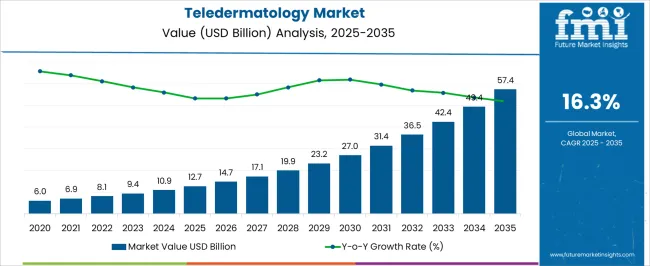
| Metric | Value |
|---|---|
| Teledermatology Market Estimated Value in (2025 E) | USD 12.7 billion |
| Teledermatology Market Forecast Value in (2035 F) | USD 57.4 billion |
| Forecast CAGR (2025 to 2035) | 16.3% |
The Teledermatology market is experiencing strong growth, driven by the increasing adoption of digital healthcare solutions and remote patient monitoring technologies. The rising prevalence of skin disorders, coupled with the shortage of dermatology specialists in certain regions, has accelerated demand for remote dermatological consultations. Advancements in high-resolution imaging, secure data transmission, and AI-assisted diagnostic tools have enhanced the accuracy and efficiency of teledermatology services.
Integration with electronic health records and healthcare management systems is further improving clinical workflows, patient engagement, and treatment outcomes. Regulatory support for telemedicine, reimbursement frameworks, and growing awareness among patients and providers are also contributing to market expansion.
The ability to provide timely diagnosis, reduce in-person visits, and improve accessibility in rural and underserved areas strengthens adoption As healthcare facilities increasingly seek scalable, cost-effective, and patient-centric solutions, the Teledermatology market is poised for sustained growth, with technological innovation and digital transformation driving demand across global healthcare systems.
The teledermatology market is segmented by type, modality, end-user, and geographic regions. By type, teledermatology market is divided into Products and Services. In terms of modality, teledermatology market is classified into Real-Time (Synchronous), Store-And-Forward (Asynchronous), and Others. Based on end-user, teledermatology market is segmented into Healthcare Facilities and Homecare. Regionally, the teledermatology industry is classified into North America, Latin America, Western Europe, Eastern Europe, Balkan & Baltic Countries, Russia & Belarus, Central Asia, East Asia, South Asia & Pacific, and the Middle East & Africa.
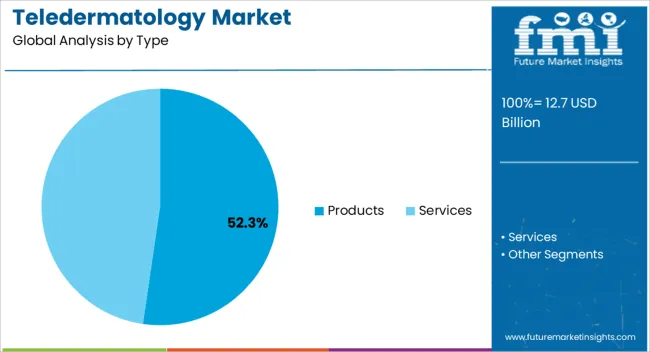
The products segment is projected to hold 52.3% of the Teledermatology market revenue in 2025, establishing it as the leading type category. Growth in this segment is being driven by the increasing deployment of specialized teledermatology hardware and diagnostic tools, including high-resolution cameras, dermatoscopes, and imaging devices that enable remote skin assessment. These products facilitate accurate clinical evaluation, integration with software platforms, and real-time data sharing between patients and dermatologists.
The ability to reduce in-person consultations and improve diagnostic efficiency has reinforced adoption among healthcare providers. Continuous technological advancements in imaging quality, portability, and interoperability with telemedicine platforms are further enhancing usability and reliability.
Cost-effectiveness, scalability, and the ability to support diverse clinical applications contribute to the strong market position of products As demand for efficient, remote dermatology services grows globally, the products segment is expected to maintain its leadership, supported by innovation in medical devices and widespread adoption in healthcare facilities.
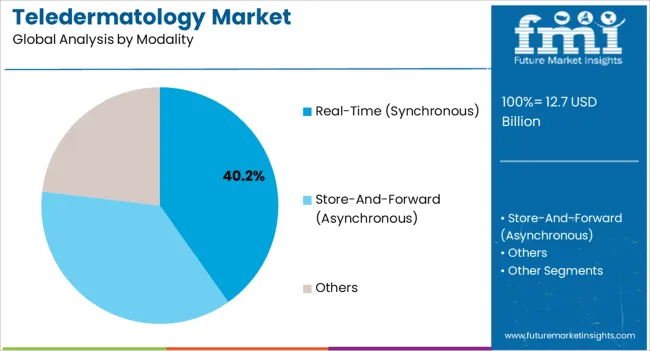
The real-time (synchronous) modality segment is expected to account for 40.2% of the market revenue in 2025, making it the leading modality category. Growth is driven by the increasing preference for live consultations, which enable immediate patient-physician interaction, rapid diagnosis, and timely treatment recommendations. Real-time teledermatology facilitates dynamic communication, visual assessment of skin conditions, and instant clarification of patient concerns, improving clinical decision-making and patient satisfaction.
Integration with electronic health record systems and AI-supported diagnostic tools enhances accuracy and efficiency. Healthcare providers are adopting synchronous solutions to optimize workflow, reduce waiting times, and expand reach to remote or underserved populations.
Regulatory acceptance of telemedicine and reimbursement incentives further support adoption As the demand for accessible, patient-centered, and technology-enabled dermatology services rises, the real-time modality segment is expected to remain the primary driver of market growth, benefiting from ongoing innovation in secure video communication, high-resolution imaging, and diagnostic support tools.
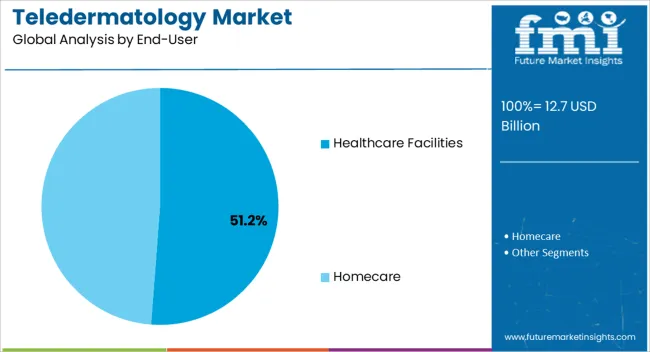
The healthcare facilities segment is projected to hold 51.2% of the Teledermatology market revenue in 2025, establishing it as the leading end-user category. Growth is driven by the increasing adoption of teledermatology solutions in hospitals, clinics, and outpatient care centers to enhance patient access, optimize workflows, and improve diagnostic efficiency. Healthcare facilities benefit from the ability to integrate teledermatology platforms with existing electronic health records, enabling comprehensive patient management and seamless data sharing.
Remote consultations reduce patient travel, minimize waiting times, and allow dermatologists to manage larger patient volumes. Investment in training, infrastructure, and digital platforms has accelerated deployment across hospitals and specialty care centers.
The combination of operational efficiency, cost-effectiveness, and improved patient outcomes has reinforced the preference for healthcare facilities as primary users As telemedicine adoption expands globally and regulatory frameworks evolve, the healthcare facilities segment is expected to maintain its leading position, supported by technological advancements and increasing demand for accessible dermatological care.
Dermatology is the field of medicine concerned with the skin, hair, nails and their diseases. It is a speciality dealing with both the medical & surgical aspects. With the rapid progression of telecommunication technology in the late 20th and early 21st century, there was a convergence of the two in the form of the teledermatology market.
The term ‘teledermatology’ was coined by dermatologists Perednia and Brown in 1995. It is a subset within dermatology where telecommunication equipment is used to transmit medical data through audio, video and data means. It typically consists of dermatology photos.
The main objectives of the teledermatology market are long-distance knowledge exchange for doctors & researchers, getting a second opinion and even being able to serve patients suffering from chronic skin conditions in far-flung regions of the globe.
Teledermatology can also save valuable time by enabling dermatologists to treat minor ailments online while leaving only serious medical conditions to be dealt with in person. There are two main concepts in teledermatology – Store and Forward (SAF) and real time teledermatology. The former is more commonly used whereas the latter is still a niche part of the teledermatology market at present.
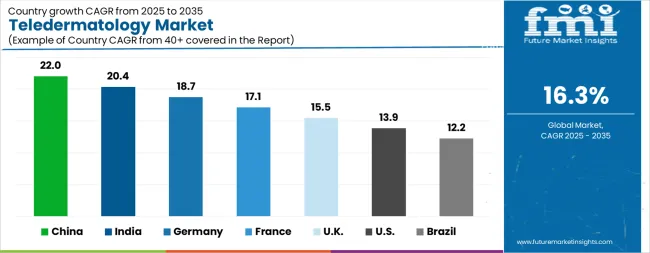
| Country | CAGR |
|---|---|
| China | 22.0% |
| India | 20.4% |
| Germany | 18.7% |
| France | 17.1% |
| UK | 15.5% |
| USA | 13.9% |
| Brazil | 12.2% |
The Teledermatology Market is expected to register a CAGR of 16.3% during the forecast period, exhibiting varied country level momentum. China leads with the highest CAGR of 22.0%, followed by India at 20.4%. Developed markets such as Germany, France, and the UK continue to expand steadily, while the USA is likely to grow at consistent rates. Brazil posts the lowest CAGR at 12.2%, yet still underscores a broadly positive trajectory for the global Teledermatology Market. In 2024, Germany held a dominant revenue in the Western Europe market and is expected to grow with a CAGR of 18.7%. The USA Teledermatology Market is estimated to be valued at USD 4.6 billion in 2025 and is anticipated to reach a valuation of USD 16.9 billion by 2035. Sales are projected to rise at a CAGR of 13.9% over the forecast period between 2025 and 2035. While Japan and South Korea markets are estimated to be valued at USD 607.3 million and USD 357.9 million respectively in 2025.
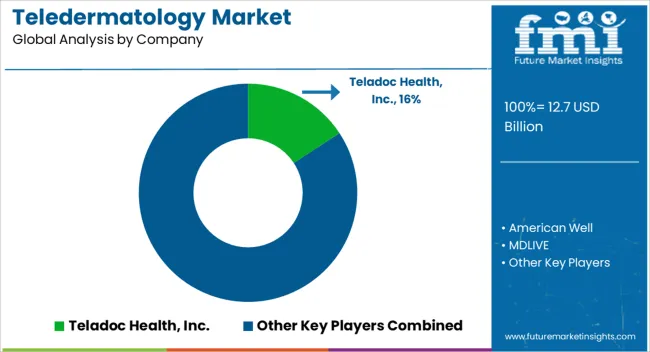
| Item | Value |
|---|---|
| Quantitative Units | USD 12.7 Billion |
| Type | Products and Services |
| Modality | Real-Time (Synchronous), Store-And-Forward (Asynchronous), and Others |
| End-User | Healthcare Facilities and Homecare |
| Regions Covered | North America, Europe, Asia-Pacific, Latin America, Middle East & Africa |
| Country Covered | United States, Canada, Germany, France, United Kingdom, China, Japan, India, Brazil, South Africa |
| Key Companies Profiled | Teladoc Health, Inc., American Well, MDLIVE, 3Derm, Doctor On Demand, Miiskin, MetaOptima Technology Inc., VisualDx, Digital Diagnostics Inc., Ksyos, and CureSkin |
The global teledermatology market is estimated to be valued at USD 12.7 billion in 2025.
The market size for the teledermatology market is projected to reach USD 57.4 billion by 2035.
The teledermatology market is expected to grow at a 16.3% CAGR between 2025 and 2035.
The key product types in teledermatology market are products, services, _teleconsultation, _telemonitoring, _tele-education and _others.
In terms of modality, real-time (synchronous) segment to command 40.2% share in the teledermatology market in 2025.






Our Research Products

The "Full Research Suite" delivers actionable market intel, deep dives on markets or technologies, so clients act faster, cut risk, and unlock growth.

The Leaderboard benchmarks and ranks top vendors, classifying them as Established Leaders, Leading Challengers, or Disruptors & Challengers.

Locates where complements amplify value and substitutes erode it, forecasting net impact by horizon

We deliver granular, decision-grade intel: market sizing, 5-year forecasts, pricing, adoption, usage, revenue, and operational KPIs—plus competitor tracking, regulation, and value chains—across 60 countries broadly.

Spot the shifts before they hit your P&L. We track inflection points, adoption curves, pricing moves, and ecosystem plays to show where demand is heading, why it is changing, and what to do next across high-growth markets and disruptive tech

Real-time reads of user behavior. We track shifting priorities, perceptions of today’s and next-gen services, and provider experience, then pace how fast tech moves from trial to adoption, blending buyer, consumer, and channel inputs with social signals (#WhySwitch, #UX).

Partner with our analyst team to build a custom report designed around your business priorities. From analysing market trends to assessing competitors or crafting bespoke datasets, we tailor insights to your needs.
Supplier Intelligence
Discovery & Profiling
Capacity & Footprint
Performance & Risk
Compliance & Governance
Commercial Readiness
Who Supplies Whom
Scorecards & Shortlists
Playbooks & Docs
Category Intelligence
Definition & Scope
Demand & Use Cases
Cost Drivers
Market Structure
Supply Chain Map
Trade & Policy
Operating Norms
Deliverables
Buyer Intelligence
Account Basics
Spend & Scope
Procurement Model
Vendor Requirements
Terms & Policies
Entry Strategy
Pain Points & Triggers
Outputs
Pricing Analysis
Benchmarks
Trends
Should-Cost
Indexation
Landed Cost
Commercial Terms
Deliverables
Brand Analysis
Positioning & Value Prop
Share & Presence
Customer Evidence
Go-to-Market
Digital & Reputation
Compliance & Trust
KPIs & Gaps
Outputs
Full Research Suite comprises of:
Market outlook & trends analysis
Interviews & case studies
Strategic recommendations
Vendor profiles & capabilities analysis
5-year forecasts
8 regions and 60+ country-level data splits
Market segment data splits
12 months of continuous data updates
DELIVERED AS:
PDF EXCEL ONLINE

Thank you!
You will receive an email from our Business Development Manager. Please be sure to check your SPAM/JUNK folder too.
Chat With
MaRIA